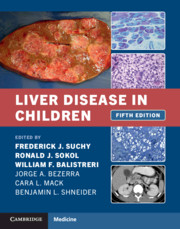Book contents
- Liver Disease in Children
- Liver Disease in Children
- Copyright page
- Contents
- Contributors
- Preface
- Section I Pathophysiology of Pediatric Liver Disease
- Section II Cholestatic Liver Disease
- Section III Hepatitis and Immune Disorders
- Chapter 17 Hepatitis A and Hepatitis E Virus in Children
- Chapter 18 Hepatitis B Virus Infection in Children
- Chapter 19 Hepatitis C Virus Infection in Children
- Chapter 20 Autoimmune Hepatitis in Children
- Chapter 21 Sclerosing Cholangitis in Children
- Chapter 22 Drug-Induced Liver Disease in Children
- Chapter 23 Liver Disease in Immunodeficiencies in Children
- Section IV Metabolic Liver Disease
- Section V Other Considerations and Issues in Pediatric Hepatology
- Index
- References
Chapter 22 - Drug-Induced Liver Disease in Children
from Section III - Hepatitis and Immune Disorders
Published online by Cambridge University Press: 19 January 2021
- Liver Disease in Children
- Liver Disease in Children
- Copyright page
- Contents
- Contributors
- Preface
- Section I Pathophysiology of Pediatric Liver Disease
- Section II Cholestatic Liver Disease
- Section III Hepatitis and Immune Disorders
- Chapter 17 Hepatitis A and Hepatitis E Virus in Children
- Chapter 18 Hepatitis B Virus Infection in Children
- Chapter 19 Hepatitis C Virus Infection in Children
- Chapter 20 Autoimmune Hepatitis in Children
- Chapter 21 Sclerosing Cholangitis in Children
- Chapter 22 Drug-Induced Liver Disease in Children
- Chapter 23 Liver Disease in Immunodeficiencies in Children
- Section IV Metabolic Liver Disease
- Section V Other Considerations and Issues in Pediatric Hepatology
- Index
- References
Summary
Drug-induced liver disease has been regarded as rare in children. Large surveys have generally failed to detect drug hepatotoxicity as a major problem in children [1], although adverse drug reactions (not necessarily hepatotoxic) are somewhat more frequent in preschool children and in children of any age with cancer. A study examining deaths from adverse drug reactions in children found that approximately one-sixth of such deaths involved acute liver failure, usually associated with antiepileptic or anti-neoplastic drugs [2].
- Type
- Chapter
- Information
- Liver Disease in Children , pp. 348 - 382Publisher: Cambridge University PressPrint publication year: 2021

